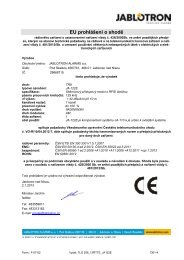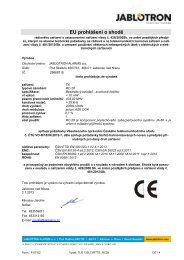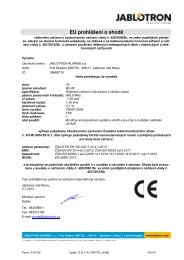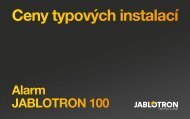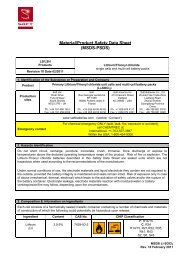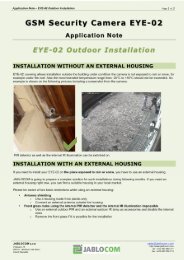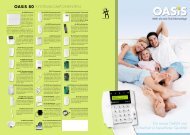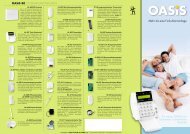MATERIAL SAFETY DATA SHEET (MSDS) - Jablotron
MATERIAL SAFETY DATA SHEET (MSDS) - Jablotron
MATERIAL SAFETY DATA SHEET (MSDS) - Jablotron
You also want an ePaper? Increase the reach of your titles
YUMPU automatically turns print PDFs into web optimized ePapers that Google loves.
Lithium Ion Batteries<br />
Page 1/5<br />
<strong>MATERIAL</strong> <strong>SAFETY</strong> <strong>DATA</strong> <strong>SHEET</strong> (<strong>MSDS</strong>)<br />
SECTION I – PRODUCT AND MANUFACTURER INFORMATION<br />
Product Name:<br />
Chemical Systems:<br />
Sizes:<br />
Designed for Recharge:<br />
Lithium Ion Battery<br />
Lithium Ion<br />
All Cylindrical and Prismatic Type<br />
Yes<br />
Well Link Industrial Limited<br />
Rm. 1116-17 Tower A, Regent Centre<br />
63 Wo Yi Hop Rd., Kwai Chung, NT., Hong Kong<br />
Telephone Number for Information: 852-24818893<br />
Date Prepared: January, 2011<br />
SECTION II – HAZARDS IDENTIFICATION<br />
- Ingestion<br />
- Inhalation<br />
- Skin Contact<br />
- Eye Contact<br />
SECTION III – INFORMATION ON INGREDIENTS<br />
WARNING: The battery should not be opened or burned. Exposure to the ingredients contained within or their<br />
combustion products could be harmful.<br />
<strong>MATERIAL</strong> OR INGREDIENTS<br />
Content.<br />
TLV<br />
(ACGIH Threshold Limit Values)<br />
Lithium Cobaltate (CAS# 12190-79-3) 30% None Established<br />
Graphite (CAS# 7782-42-5) 16% 2.5mg/m 3 (as dust)<br />
Organic Solvent 13% None Established<br />
Lithium Salt 1% None Established<br />
Weight of Lithium per cell : 0 gram<br />
There is no metallic lithium in lithium ion battery and are all applicable to the UN Recommendations/Special<br />
Provision 188 and Special Provision A45 of the ICAO and IATA and thus can be transported as ‘Non-Dangerous<br />
Goods’.<br />
PROFESSIONAL BATTERY MANUFACTURER: NiMH rechargeable battery . NiCd rechargeable battery . Li-Ion rechargeable battery . Lithium polymer rechargeable battery .<br />
SLA rechargeable battery . Alkaline battery . Lithium battery . Zinc chloride battery . Carbon zinc battery
Lithium Ion Batteries<br />
Page 2/5<br />
SECTION IV – FIRST-AID MEASURES<br />
Ingestion:<br />
Swallowing a battery can be harmful. Seek medical attention immediately. Call The National Capital<br />
Poison Control Center (202-625-3333) collect, or your local Poison Control Center (800-222-1222), day or<br />
night, for advice and follow-up.<br />
Inhalation:<br />
Contents of an open battery can cause respiratory irritation.<br />
Provide fresh air and seek medical attention.<br />
Skin Contact:<br />
Contents of an open battery can cause skin irritation and/or chemical burns. Remove contaminated clothing<br />
and wash skin with soap and water. If a chemical burn occurs or if irritation persists, seek medical<br />
attention.<br />
Eye Contact:<br />
Contents of an open battery can cause severe irritation and/or chemical burns. Immediately flush eyes<br />
thoroughly with copious quantities of flowing lukewarm water for a minimum of 15 minutes. Seek<br />
immediate medical attention.<br />
SECTION V – FIRE FIGHTING MEASURES<br />
If fire or explosion occurs when batteries are on charge, shut off power to charger.<br />
In case of fire where lithium ion batteries are present, flood the area with water. If any batteries are burining,<br />
water may not extinguish them, but will cool the adjacent batteries and control the spread of fire. CO 2 , dry<br />
chemical and foam extinguishers are preferred for small fires, but also may not extinguish burning lithium<br />
ion batteries. Burning batteries will burn themselves out. Virtually all fires involving lithium ion batteries can<br />
be controlled with water. When water is used, however, hydrogen gas may be evolved which can form an<br />
explosive mixture with air. LITH-X (powdered graphite) or copper powder fire extinguishers, sand dry<br />
ground dolomite or soda ash may also be used. These materials act as apply smothering agents.<br />
Fire fighters should wear self-contained breathing apparatus. Burning lithium ion batteries can produce toxic<br />
fumes including HF, oxides of carbon, aluminum, lithium, copper and cobalt.<br />
SECTION VI - SPILL OR LEAK PROCEDURES<br />
Procedures to Contain and Clean Up Leaks or Spills:<br />
The preferred response is to leave the area and allow the batteries to cool and the vapors to dissipate. Avoid<br />
skin and eye contact or inhalation of vapors. Remove spilled liquid with absorbent and incinerate.<br />
Reporting Procedure:<br />
Report all spills in accordance with Federal, State and Local reporting requirements.<br />
PROFESSIONAL BATTERY MANUFACTURER: NiMH rechargeable battery . NiCd rechargeable battery . Li-Ion rechargeable battery . Lithium polymer rechargeable battery .<br />
SLA rechargeable battery . Alkaline battery . Lithium battery . Zinc chloride battery . Carbon zinc battery
Lithium Ion Batteries<br />
Page 3/5<br />
SECTION VII - PRECAUTIONS FOR SAFE HANDLING AND USE<br />
Storage:<br />
Store in a cool, dry, and well-ventilated area. Elevated temperature can result in shortened battery life.<br />
Storing unpackaged cells together could result in cell shorting and heat build-up.<br />
Mechanical Containment:<br />
Do not obstruct safety release vents on batteries. Encapsulation (potting) of batteries will not allow cell<br />
venting and can cause high-pressure rupture.<br />
Handling:<br />
Accidental short circuit for a few seconds will not seriously affect the battery. However, this battery is<br />
capable of delivering very high short circuit currents. Prolonged short circuits will cause high cell<br />
temperatures that can cause skin burns. Sources of short circuits include jumbled batteries in bulk containers,<br />
metal jewelry, and metal covered tables or metal belts used for assembly of batteries into devices.<br />
If soldering or welding to the battery is required, use of tabbed batteries is recommended.<br />
Do not disassemble or deform battery.<br />
Charging:<br />
This battery is made to be charged many times. Because it gradually loses its charge over a few months, it is<br />
good practice to charge battery before use. Use recommended charger. Improper charging can cause heat<br />
damage or even high pressure rupture. Observe proper charging polarity.<br />
SECTION VIII – PERSONAL PROTECTION<br />
Respiratory Protection (Specify Type)<br />
Ventilation<br />
Protective Gloves<br />
Eye Protection<br />
Other Protective Clothing<br />
Not necessary under normal conditions<br />
Not necessary under normal conditions<br />
Not necessary under normal conditions<br />
Not necessary under normal conditions<br />
Not necessary under normal conditions<br />
SECTION IX - PHYSICAL <strong>DATA</strong><br />
Specific Gravity : (H20=1) LiCoO2 : 4.95<br />
Graphite : 2.09-2.2<br />
Melting Point ( o C)<br />
LiCoO2 : ~1130 o C<br />
Appearance and Odor<br />
LiCoO2 is a black, ordorless powder<br />
Graphite is a black, ordorless powder<br />
Organic solvent is a colorless or light yellow liquid<br />
Lithium Salt is a white, crystalline and odorless<br />
powder<br />
PROFESSIONAL BATTERY MANUFACTURER: NiMH rechargeable battery . NiCd rechargeable battery . Li-Ion rechargeable battery . Lithium polymer rechargeable battery .<br />
SLA rechargeable battery . Alkaline battery . Lithium battery . Zinc chloride battery . Carbon zinc battery
Lithium Ion Batteries<br />
Page 4/5<br />
SECTION X - REACTIVITY <strong>DATA</strong><br />
Stable or Unstable<br />
Conditions to Avoid<br />
Hazardous Decomposition Reactions<br />
Stable<br />
Do not heat, disassemble or overcharge<br />
N/A<br />
Hazardous polymerization will not occur<br />
SECTION XI - HEALTH HAZARD <strong>DATA</strong><br />
Under normal conditions of use, the battery is hermetically sealed. Risk of exposure occurs only if the<br />
battery is mechanically or electrically abused. Organic solvent has slightly toxicity and can irritate skin and<br />
eyes. Lithium salt is irritating to skin, eyes and mucous membranes and should be avoided.<br />
Carcinogenicity :<br />
NTP :<br />
None<br />
IARC Monograph : None<br />
OSHA Regulated : None<br />
SECTION XII – FIRE & EXPLOSION HAZARD <strong>DATA</strong><br />
Flash Point<br />
Flammable Limits in Air (%)<br />
Lower (LEL)<br />
Upper (LEL)<br />
Extinguishing Media<br />
Auto-Ignition<br />
NA unless individual components exposed<br />
NA unless individual components exposed<br />
NA unless individual components exposed<br />
NA unless individual components exposed<br />
Water<br />
NA unless individual components exposed<br />
SECTION XIII – Disposal Method<br />
Disposal in accordance with Federal, State and Local reporting requirements.<br />
SECTION XIV – TRANSPORTATION<br />
KINETIC lithium ion batteries are not subject to requirements of the U.S. Hazardous Materials Regulations<br />
pursuant to 49 CFR 173.185(b), IATA Dangerous Goods Regulations pursuant to Special Provision A45, and<br />
IMDG Code pursuant to Special Provision 188.<br />
Batteries must be packaged and offered for transportation in a manner that prevents the dangerous evolution<br />
of heat and protects against short circuits.<br />
PROFESSIONAL BATTERY MANUFACTURER: NiMH rechargeable battery . NiCd rechargeable battery . Li-Ion rechargeable battery . Lithium polymer rechargeable battery .<br />
SLA rechargeable battery . Alkaline battery . Lithium battery . Zinc chloride battery . Carbon zinc battery
Lithium Ion Batteries<br />
Page 5/5<br />
Effective January 1, 2011, all KINETIC lithium coin cell batteries can be shipped by air in accordance with<br />
International Civil Aviation Organization (ICAO), Section II or International Air Transport Association<br />
(IATA) current 52nd 2011 edition, Section II Packing Instructions (PI) 965 (Batteries)<br />
SECTION XV – REGULATORY INFORMATION<br />
These products are “article(s)” that do not release a covered toxic chemical under the normal conditions of<br />
processing or use. They are not subject to the requirements of the Emergency Planning and Community<br />
Right-To-Know Act. Notification is not required.<br />
SECTION XVI – OTHER INFORMATION<br />
The battery referenced herein is defined as “article” and is NOT subject to the 29 CFR 1910.1200 OSHA Hazard<br />
Communication Standard requirement or to the Canadian WHMIS requirement. Hence, a material safety data<br />
sheet (<strong>MSDS</strong>) is not required. The information and recommendation set forth herein are supplied as a service.<br />
They are made in good faith and believed to be accurate as of the date of preparation. Well Link makes no<br />
warranty, either express or implied, with respect to this information and disclaims all liability from reliance on it.<br />
PROFESSIONAL BATTERY MANUFACTURER: NiMH rechargeable battery . NiCd rechargeable battery . Li-Ion rechargeable battery . Lithium polymer rechargeable battery .<br />
SLA rechargeable battery . Alkaline battery . Lithium battery . Zinc chloride battery . Carbon zinc battery



